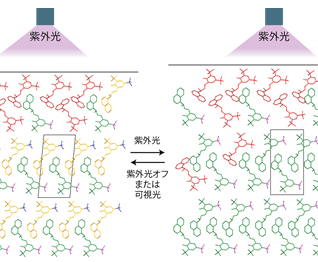New structural phase transition may broaden the applicability of photo-responsive solids
Tue, Mar 26, 2019-
Tags
Scientists discover possibility of remotely controlling next-generation actuators by light
Caption: Photo-triggered phase transition of the photochromic chiral salicylideneamine crystal upon UV light irradiation (Credit: Waseda University)
A team of scientists from Waseda University in Tokyo and Rigaku Corporation discovered a new type of structural phase transition of an organic crystal, called the photo-triggered phase transition.
Hideko Koshima, a visiting professor at Waseda’s Research Organization for Nano & Life Innovation and leading author of this study, says, “Phase transition mechanisms are widely used in memory, switch, and actuation materials, and we believe that this discovery of a new phase transition has potential for both basic science and application fields.”
Their study was published in Communications Chemistry on February 20, 2019.
Induced by external stimuli such as temperature, pressure, electromagnetic fields, and light, a structural phase transition is a phenomenon that changes the physical properties and functions of solid-state materials. For instance, shape memory alloys, which have applications in robotics and in automotive, aerospace, and biomedical industries, recover its shape upon heating due to martensitic transitions. In recent years, organic crystals have been considered ‘fascinating candidates’ as materials for next-generation actuators because of their properties, such as its softness and light weight.
Prior to this study, the team has reported that they developed a mechanical crystal which bends with exposure to light, as well as a robotic crystal which ‘walks and rolls’ when heated and cooled. The actuation of these crystals can be respectively explained by a photochromic reaction, known as photoisomerization, and structural phase transition. To diversify the movements of such crystals, scientists have been looking for organic crystals which exhibit both phenomena.
Finding such crystal is no easy task and requires trial-and-error. However, when the team was studying an organic crystal called the photochromic chiral salicylideneamine crystal, not only did they find that this crystal exhibits both phenomena, but they also discovered the new structural phase transition.
“We accidentally stumbled upon the photo-triggered phase transition of the photochromic chiral salicylideneamine crystal, which exhibits a thermal phase transition that is reversible upon heating and cooling,” explains Professor Koshima. “When irradiating this crystal with ultraviolet light at -50 °C, a temperature lower than its thermal transition temperature (40 °C), we found from an X-ray crystallographic analysis that the crystal undergoes transformation identical to that of a thermal phase transition.”
The team also learned that the photo-triggered phase transition occurs because of the strain of molecules produced by photoisomerization, and Koshima adds that the photo-triggered phase transition differs from a photo-induced phase transition, which has appeared in other publications.
“The crystal phase due to the photo-induced phase transition appears only by light irradiation, which changes the electric and/or magnetic properties of the crystals within femto- or picoseconds. In the photo-triggered phase transition, the crystal phase triggered by light is identical to that via thermal phase transition, induced by heating, but unique with respect to its molecular conformation,” she says.
Because the photo-triggered phase transition is induced by light irradiation and does not require heating and cooling for the structural phase transition to occur, the team’s findings may ‘lead to a new strategy to broaden applicability of photo-responsive solids’ and contribute to research and development of next-generation sensing, switching, memory, and actuators that enable remote control and/or local operation by light.
The team is now planning to measure and quantitatively evaluate the magnitude of the crystal’s strain caused by photoisomerization, systematically investigate whether the photo-triggered phase transition occurs in other crystals using materials informatics, and clarify its conditions.
About the published article
Published in Communications Chemistry on February 20, 2019
Title: Observation of dressed states of distant atoms with delocalized photons in coupled-cavities quantum electrodynamics
Authors: Takuya Taniguchi, Hiroyasu Sato, Yuki Hagiwara, Toru Asahi, Hideko Koshima
DOI: 10.1038/s42004-019-0121-8














